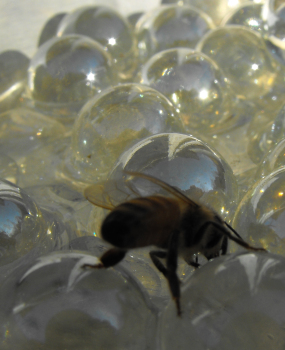View this newsletter online: http://www.savingdinner.com/news/BestNonAnmialProtein.html
Best non-animal protein sources
by Leanne Ely
Protein is found in each and every muscle, cell and tissue of our
bodies. We need protein to repair, grow and maintain all of our cells.
Almost every process in our bodies requires protein. It's a major
component of all of our tissues, organs and muscles. We also need
protein to produce the antibodies that fight infection and illness. It
makes our nails strong, our bones strong and our hair shiny.
Protein is very important, folks.
So what do you do if you want to eat more protein without adding
more meat to your diet? Luckily for those of us with children who aren't
fans of meat and for vegetarians, there are many foods rich in protein
that never once mooed, quacked or oinked. Note: Not all of these forms
of protein are paleo-friendly, but hey, not everyone has hopped aboard
the paleo train just yet!

Avocado. Not only is avocado high in protein but it's
also a great source of fiber. It also provides omega 6 essential fats
and omega 3s as well. 15 avocados equal the amount of protein you'd get
from one chicken breast.
Quinoa. Quinoa has been around forever. It's often
eaten as a starch, in place of rice or couscous, but quinoa is actually
more of a seed than it is a grain. It's also extremely high in protein
and unlike other grains it's a complete protein.
Peas. Peas are high in Vitamins K and C, fiber and
other minerals in addition to being a good source of protein. Peas
aren't a complete protein, though, so eat them with quinoa or cheese to
get lots of amino acids into you.
Greek yogurt. Greek yogurt is a great source of
protein and it's a good way to sneak in some calcium, too. Just make
sure you buy the plain variety and read your labels to make sure you
choose a brand that's not too high in sugar. <---Not Veagan
Chick peas. Chick peas are 23% protein and they aren't expensive. Buy organic chick peas and eat them as an alternative to meat.
Peanut butter. Peanut butter is 28% protein.
Peanuts also contain a heart-healthy antioxidant called resveratrol
which is the same component that makes red wine good for us.
Coconut. Coconut is another complete protein and
it's also high in fiber. It's a tad high in fat, but it is a medium
chain triglyceride and your body uses it as energy immediately rather
than storing it. So don't be afraid of it! That doesn't mean you should
drink it by the cupful, but don't be afraid to incorporate this and
other healthy fats into your diet.
Brown rice. Brown rice is low on the glycemic index, it's rich in minerals and high in fiber. It's also a good source of protein.
Among the different emotions that animals display clearly and unambiguously is grief. Many animals display profound grief at the loss or absence of a close friend or loved one. Nobel laureate ethologist Konrad Lorenz writes: "A greylag goose that has lost its partner shows all the symptoms that [developmental psychologist] John Bowlby has described in young human children in his famous book Infant Grief . . . the eyes sink deep into their sockets, and the individual has an overall drooping experience, literally letting the head hang . . ." Sea lion mothers, watching their babies being eaten by killer whales, wail pitifully, anguishing their loss. Dolphins have been seen struggling to save a dead infant and mourn afterward. Stories about grief stricken companion animals abound; see also).
Cynthia Moss describes the actions of the members of an elephant family above after a group member had been shot: "Teresia and Trista became frantic and knelt down and tried to lift her up. They worked their tusks under her back and under her head. At one point they succeeded in lifting her into a sitting position but her body flopped back down. Her family tried everything to rouse her, kicking and tusking her, and Tullulah even went off and collected a trunkful of grass and tried to stuff it in her mouth."
Iain Douglas-Hamilton and his colleagues have shown that elephants extend this compassion to nonrelatives, to those who aren't genetically related, and at least one anecdote shows them extending it to humans. A news report told of an elephant in northern Kenya that trampled a human mother and her child and then stopped to bury them before disappearing in the bush. Elephants don't show concern just for their own kin, or their own kind, but rather elephants show a general concern for the plight of others.
Nonhuman primates also grieve the loss of others. Gana, a captive gorilla, clearly grieved the loss of her infant and the image of her carrying her dead baby was shown around the world. Jane Goodall observed Flint, a young chimpanzee, withdraw from his group, stop eating, and die of a broken heart after the death of his mother, Flo. Here is Goodall's description from her book Through a Window:
"Never shall I forget watching as, three days after Flo's death, Flint climbed slowly into a tall tree near the stream. He walked along one of the branches, then stopped and stood motionless, staring down at an empty nest. After about two minutes he turned away and, with the movements of an old man, climbed down, walked a few steps, then lay, wide eyes staring ahead. The nest was one which he and Flo had shared a short while before Flo died. . . . in the presence of his big brother [Figan], [Flint] had seemed to shake off a little of his depression. But then he suddenly left the group and raced back to the place where Flo had died and there sank into ever deeper depression. . . . Flint became increasingly lethargic, refused food and, with his immune system thus weakened, fell sick. The last time I saw him alive, he was hollow-eyed, gaunt and utterly depressed, huddled in the vegetation close to where Flo had died. . . . the last short journey he made, pausing to rest every few feet, was to the very place where Flo's body had lain. There he stayed for several hours, sometimes staring and staring into the water. He struggled on a little further, then curled up— and never moved again."
Another story of grieving chimpanzees recently was reported in the Daily Mail.
Gorillas are known to hold wakes for dead friends, something that some zoos have formalized in a ceremony when one of their gorillas passes away. Donna Fernandes, now president of the Buffalo Zoo, tells the story of being at Boston's Franklin Park Zoo ten years ago during the wake for a female gorilla, Babs, who had died of cancer. She describes seeing the gorilla's longtime mate say good-bye: "He was howling and banging his chest,... and he picked up a piece of her favorite food — celery — and put it in her hand and tried to get her to wake up. I was weeping, it was so emotional." Later, the scene at Babs's December funeral was similarly moving. As reported by local news, gorilla family members "one by one ... filed into" the room where "Babs's body lay," approaching their "beloved leader" and "gently sniffing the body."
When Sylvia, a baboon, lost Sierra, her closest grooming partner and daughter to a lion, she responded in a way that would be considered very human-like: she looked to friends for support. Said Anne Engh, a researcher in he University of Pennsylvania's Department of Biology. "With Sierra gone, Sylvia experienced what could only really be described as depression, corresponding with an increase in her glucocorticoid levels."
Jim and Jamie Dutcher describe the grief and mourning in a wolf pack after the loss of the low-ranking omega female wolf, Motaki, to a mountain lion. The pack lost their spirit and their playfulness. They no longer howled as a group, but rather they "sang alone in a slow mournful cry." They were depressed — tails and heads held low and walking softly and slowly — when they came upon the place where Motaki was killed. They inspected the area and pinned their ears back and dropped their tails, a gesture that usually means submission. It took about six weeks for the pack to return to normal. The Dutchers also tell of a wolf pack in Canada in which one pack member died and the others wandered about in a figure eight as if searching for her. They also howled long and mournfully. Foxes also have been observed performing funeral rituals.
My friend Betsy Webb who lives in Homer, Alaska, told me a moving story about grief in llamas. She wrote:
Why do animals grieve and why do we see grief in different species of animals? It's been suggested that grief reactions may allow for the reshuffling of status relationships or the filling the reproductive vacancy left by the deceased, or for fostering continuity of the group. Some theorize that perhaps mourning strengthens social bonds among the survivors who band together to pay their last respects. This may enhance group cohesion at a time when it's likely to be weakened.
Grief itself is something of a mystery, for there doesn't seem to be any obvious adaptive value to it in an evolutionary sense. It does not appear to increase an individual's reproductive success. Whatever its value is, grief is the price of commitment, that wellspring of both happiness and sorrow.
Related Articles
- Hierarchy of Death? When Your Dog Dies, You're Never Alone
- The Elephant's Nose
- My Dog Was Ready To Die—I Couldn't Let Go
- Cruelty can't stand the spotlight: Ending animal abuse is merely a click away so let's make it a New Year's resolution
- The Dolphin's death pool: Let's get these amazing beings out of Siegfried and Roy's Secret Garden of pain and suffering






 We're still
We're still .jpg)








